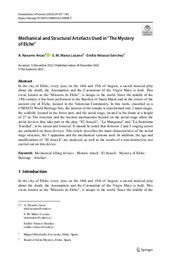Please use this identifier to cite or link to this item:
https://hdl.handle.net/11000/34638Full metadata record
| DC Field | Value | Language |
|---|---|---|
| dc.contributor.author | VELASCO SANCHEZ, EMILIO | - |
| dc.contributor.author | Navarro-Arcas, Abel | - |
| dc.contributor.author | Marco Lozano, Sixto Manuel | - |
| dc.contributor.other | Departamentos de la UMH::Ingeniería Mecánica y Energía | es_ES |
| dc.date.accessioned | 2025-01-16T18:16:52Z | - |
| dc.date.available | 2025-01-16T18:16:52Z | - |
| dc.date.created | 2024 | - |
| dc.identifier.citation | Foundations of Science | es_ES |
| dc.identifier.issn | 1572-8471 | - |
| dc.identifier.issn | 1233-1821 | - |
| dc.identifier.uri | https://hdl.handle.net/11000/34638 | - |
| dc.description.abstract | In the city of Elche, every year, on the 14th and 15th of August, a sacred musical play about the death, the Assumption and the Coronation of the Virgin Mary is held. This event, known as the “Misterio de Elche”, is unique in the world. Since the middle of the 15th century it has been performed in the Basilica of Santa Maria and in the streets of the ancient city of Elche, located in the Valencian Community. In this work, classified as a UNESCO World Heritage Site, the interior of the temple is transformed into 2 main stages, the scaffold, located in the lower part, and the aerial stage, located in the dome at a height of 27 m. The structure and the traction mechanisms located on the aerial stage allow the aerial devices that take part in the play, “El Araceli”, “La Mangrana” and “La Santísima Trinidad”, to be raised and lowered. It should be noted that between 2 and 5 singing actors are embarked on these devices. This article describes the main characteristics of the aerial stage structure, the 3 apparatus and the mechanical systems used. In addition, the age and modifications of “El Araceli” are analysed, as well as the results of a non-destructive test carried out on this device. | es_ES |
| dc.format | application/pdf | es_ES |
| dc.format.extent | 27 | es_ES |
| dc.language.iso | eng | es_ES |
| dc.publisher | Springer | es_ES |
| dc.relation.ispartofseries | 29 | es_ES |
| dc.rights | info:eu-repo/semantics/openAccess | es_ES |
| dc.rights | Attribution-NonCommercial-NoDerivatives 4.0 Internacional | * |
| dc.rights.uri | http://creativecommons.org/licenses/by-nc-nd/4.0/ | * |
| dc.subject | Mechanical lifting devices | es_ES |
| dc.subject | Historic winch | es_ES |
| dc.subject | El Araceli | es_ES |
| dc.subject | Mystery of Elche | es_ES |
| dc.subject | Heritage | es_ES |
| dc.subject | Artefact | es_ES |
| dc.subject.other | CDU::6 - Ciencias aplicadas::62 - Ingeniería. Tecnología::621 - Ingeniería mecánica en general. Tecnología nuclear. Electrotecnia. Maquinaria | es_ES |
| dc.title | Mechanical and Structural Artefacts Used in “The Mystery of Elche” | es_ES |
| dc.type | info:eu-repo/semantics/article | es_ES |
| dc.relation.publisherversion | https://doi.org/10.1007/s10699-022-09893-7 | es_ES |

View/Open:
s10699-022-09893-7 (2).pdf
3,79 MB
Adobe PDF
Share:
.png)
